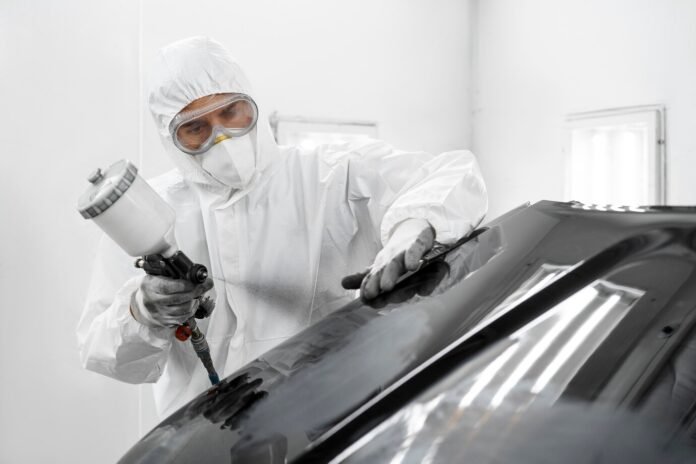Paint Protection Film, commonly known as PPF or clear bra, has become an essential accessory for car owners who want to preserve the appearance and value of their vehicles. Originally developed for military use to protect helicopter blades from debris, PPF has now evolved into a high-tech solution for automotive protection. This transparent, self-healing film acts as a shield against stone chips, scratches, bug splatter, road salt, and even minor abrasions. With vehicles being a significant investment, many owners are turning to PPF not only to maintain that showroom shine but also to avoid costly repainting and repairs. In this article, we’ll dive deep into what PPF is, how it works, its benefits, installation process, and why it might be the best decision you make for your vehicle.
What Is Paint Protection Film and How Does It Work?
Paint Protection Film is a thermoplastic urethane film that is applied to the painted surfaces of a vehicle to protect it from external damage. It is virtually invisible once applied, allowing the original color and finish of the car to show through. The most advanced films today come with self-healing properties, meaning that minor scratches or swirl marks can disappear over time when exposed to heat—like the sun or hot water. PPF works as a sacrificial layer, absorbing impacts from small rocks, road debris, and environmental contaminants before they reach the paint. Because of its elasticity and resilience, the film can stretch and mold over complex curves and edges, offering full-body protection or targeted coverage for high-impact areas like the hood, bumpers, and side mirrors.
Benefits of Installing Paint Protection Film
There are several compelling reasons why vehicle owners invest in Paint Protection Film. First and foremost is the preservation of resale value. A vehicle with a pristine, scratch-free exterior is far more appealing to potential buyers. PPF also reduces the need for frequent touch-ups or repaints, which can be costly and often result in color mismatches. Another major advantage is its self-healing capabilities—unlike traditional wax or ceramic coatings, PPF can actually repair itself from light abrasions and scuffs. Additionally, modern films often include hydrophobic properties that repel water, dirt, and oil, making the vehicle easier to clean. It also protects against UV rays that cause paint to fade over time. With all these benefits, it’s easy to see why PPF is becoming a staple in vehicle care and maintenance.
The Installation Process: What to Expect
Installing Paint Protection Film is a meticulous process that requires precision, experience, and the right tools. It usually begins with a thorough cleaning of the vehicle to ensure that no dirt, dust, or oil is trapped under the film. Any imperfections on the paint—such as swirl marks or scratches—may also be corrected before installation. The film is then custom-cut to fit the vehicle’s panels either using pre-designed templates or by hand. After application, the film is carefully squeegeed into place to remove air bubbles and ensure full adhesion. While some enthusiasts attempt DIY installation, it’s highly recommended to have the film installed by a certified professional to guarantee optimal results and avoid costly mistakes.
Paint Protection Film vs. Ceramic Coating: What’s the Difference?
While both PPF and ceramic coating offer protection and enhance the vehicle’s appearance, they serve different purposes and work in different ways. Ceramic coatings, on the other hand, are liquid polymers that chemically bond with the paint and provide a hard, glossy layer that repels water and dirt but doesn’t offer impact resistance. In fact, many car owners choose to use both: applying PPF to high-impact areas and then layering a ceramic coating on top for added shine and ease of cleaning. Understanding the unique strengths of each can help you make an informed decision on the best protection strategy for your car.
How Long Does Paint Protection Film Last?
One of the most attractive features of modern Paint Protection Film is its durability. High-quality films can last anywhere from 5 to 10 years depending on the brand, usage, and environmental exposure. Factors such as frequent sun exposure, road salt, and improper washing techniques can degrade the film over time. However, with proper care, PPF can continue to protect your vehicle effectively for many years. Regular washing using pH-neutral car shampoos, avoiding harsh chemicals, and occasionally using a detailing spray can help maintain the film’s clarity and performance. Many manufacturers also offer warranties that cover yellowing, cracking, and peeling, offering additional peace of mind for the vehicle owner.
Conclusion: Is PPF Worth the Investment?
For those who are passionate about maintaining the appearance and value of their vehicles, Paint Protection Film is undoubtedly a worthwhile investment. While the upfront cost may seem high, it pales in comparison to the potential expense of repainting or repairing damaged body panels. Whether you own a luxury car, a daily driver, or a classic showpiece, PPF offers unmatched protection and peace of mind. With advancements in technology, today’s films are more durable, more invisible, and more effective than ever. When you consider the long-term benefits, ease of maintenance, and aesthetic preservation, PPF stands out as a smart choice for anyone serious about automotive care.


